Advanced Inorganic Materials for Lighting
Alexander Birkel1, Kristin A. Denault2,3, Nathan C. George4, Ram Seshadri1,2,3
1Mitsubishi Chemical Center for Advanced Materials,, 2Solid State Lighting and Energy Center, 3Materials Department, 4Department of Chemical Engineering, University of California, Santa Barbara, CA 93106
A Bright Future for Solid-State Lighting
In 1907, the first electroluminescent device, with silicon carbide (Prod. Nos. 594911, 378097, 357391) as the active material, was described by Henry Round as displaying a “bright glow”.1,2 Lighting based on solid-state devices has since come a long way. The development of bright “candela-class” green, blue, and near-UV diodes by Nakamura3 in the 1990s was a major breakthrough, completing the spectral gamut of white light and allowing solid state lighting (SSL) to develop into a viable alternative to other, lowerefficiency light sources, such as incandescent bulbs and even compact fluorescent lamps (CFL). Offering higher efficiencies, longer lifetimes (50,000 to 100,000 hours, compared to up to 15,000 for CFL’s and only 1,000 - 2,000 for incandescent light bulbs), and the absence of toxic elements such as mercury, SSL is on the verge of becoming the standard technology for artificial light sources.4-6
White solid-state light can be generated using three different approaches: By employing three diodes that emit red, green and blue light respectively, by using a near-UV LED that excites several phosphors that emit over the complete spectral range, or the third, most widely used alternative entailing down-conversion of a portion of blue LED light to longer wavelengths in such a manner that white light emerges. The other strategies are less used due to certain intrinsic difficulties. For example, LEDs that efficiently emit in the green region of the visible spectrum cannot currently be produced and this holds back the three-LED strategy, and the near-UV with full down-conversion strategy is intrinsically inefficient due to the large Stokes shifts involved. Inorganic phosphors play a key role in carrying out the widely employed partial down-conversion strategy.7
Phosphors provide the necessary green/yellow/red light needed, in addition to the originally emitted blue, for a white light source. Inorganic phosphors usually consist of a host crystal that could be an oxide, oxynitride, nitride, halide or oxyhalide selected for their wide band gaps and other key features, doped with a small amount of rare earth and/or transition metal ions that act as the emissive center.8-12 As shown in the CIE (Commission Internationale de l’Eclairage) diagram in Figure 1, virtually every color can be rendered with the use of inorganic luminescent materials in combination with a near-UV or blue light source.
Phosphors can be prepared using the rare earth ions such as Eu3+, Tb3+ or Sm3+. However, in these systems, the emission relies on f to f transitions which are parity forbidden and therefore rather inefficient. In addition, the lower lying f-orbitals are rather well-shielded from the coordination environment of the ion and, consequently, the emission arising from those f-f transitions are sharp and not very suitable for covering a large region of the visible spectrum. To circumvent these issues of narrow, inefficient emission, the most frequently used phosphors are doped with broad-emitting ions, such as Mn2+, Ce3+, or Eu2+ (see also the examples in Figure 1). In the case of Ce3+ and Eu2+, light is emitted due to 4f to 5d transitions within the ion. In the free Ce3+ ion, the 5d states are degenerate and lie at a much higher energy above the two 4f ground states of the ion. However, d-orbitals have a pronounced interaction with the crystalline lattice, as indicated in Figure 2 for the case of Ce3+. Once introduced into a host lattice, the energy levels of the d-orbitals are reduced due to their interactions with the surrounding ligands (centroid shift due to the nephelauxetic effect). The crystal field splitting, due to the varying interactions of the ligands with the different (xy, xz, yz, x2-y2, z2) d-orbitals, lifts the degeneracy and, in most structures, leads to as many as five states distinct in energy. The difference in energy between the d-states in the free ion and the lowest lying d-state in the crystalline host is called D(A), or the spectroscopic red-shift.13
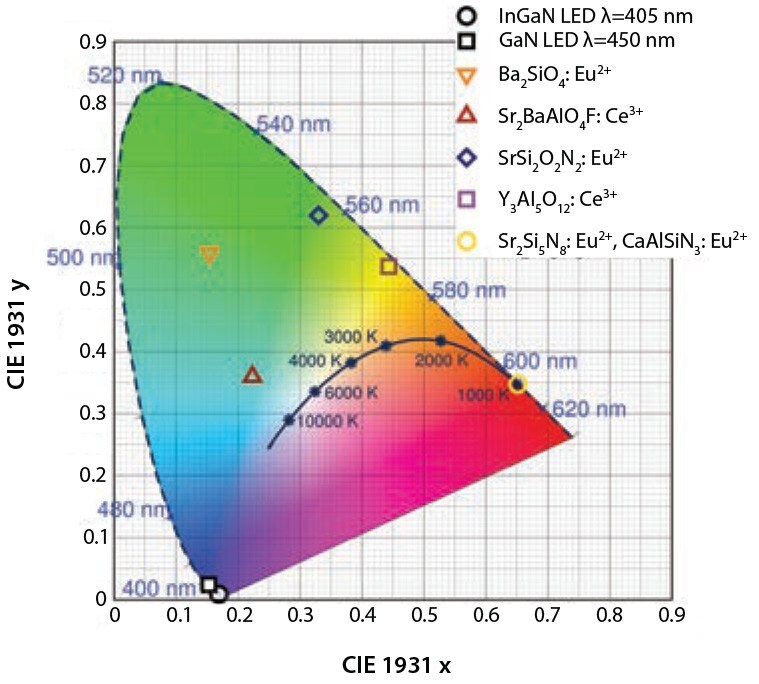
Figure 1.Color coordinates of some phosphor materials, and of blue and near-UV LEDs.
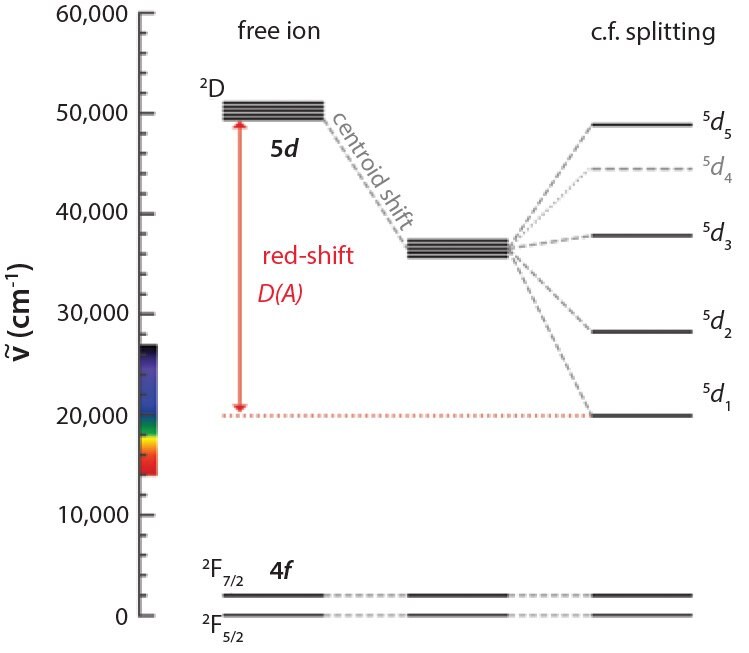
Figure 2.Electronic states of the free cerium ion and the crystal field splitting that is observed in host matrices.5
The Quest for Improved Materials
As a consequence of being so crucial for SSL, significant research efforts have been expended on the development of new phosphor materials. A schematic representation of this type of solid-state white lighting device is shown in Figure 3. It consists of a blue-emitting LED chip with the phosphor directly above the chip, dispersed in a transparent silicone12, or in form of a cap, as shown in Figure 3. The blue light passes through this phosphor layer that converts part of the blue light to yellow, which yields (cool) white light. There are many issues of efficiency (many phosphors do not possess near 100% quantum efficiency), appropriate color rendition, and color temperature that drive phosphor research. Also important is loss of efficiency at elevated temperatures that is becoming increasingly relevant to higher-power LED white light sources, such as those used in the front-lighting of automobiles.
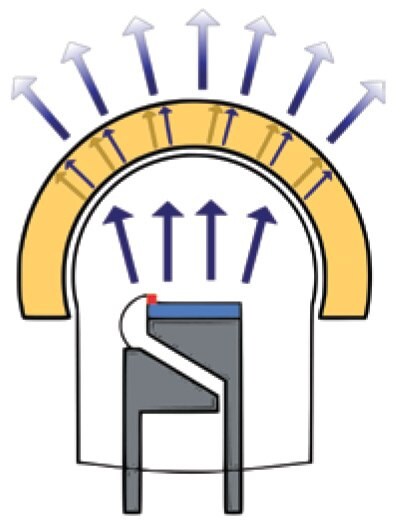
Figure 3.Representation of the generation of white light by emission of blue light from a LED, which is then down-converted by a yellow phosphor encapsulated in silicone resin cap.
To achieve the best possible device efficiency, phosphors need to fulfill certain requirements, which include, but are not limited to the following:
- A very high quantum efficiency, in order to maximize the number of photons that are (re)-emitted by the phosphors.
- A suitable excitation and emission spectrum. The excitation spectrum of the phosphor should possess considerate spectral overlap with the emission spectrum of the LED in order for efficient pumping to be achieved. An example is presented in Figure 4, showing the emission and excitation spectrum of cerium-doped Y3Al5O12 (YAG) (Prod. No. 634638). The emission of the phosphor itself should be broad, thus well reproducing the wide spectral gamut of the sun. This property is measured as the color-rendering index, CRI or Ra, which compares the color rendering of any light source to a reference black body source at temperatures near 5000 K. Values of 90 or more are desirable.
- Excellent device and color stability in regards to both chemical and thermal factors. This is important for the long term prospects of solid state lighting devices. It is also important for the use of phosphors on high power LED chips, which can reach temperatures of nearly 200 °C under operation.
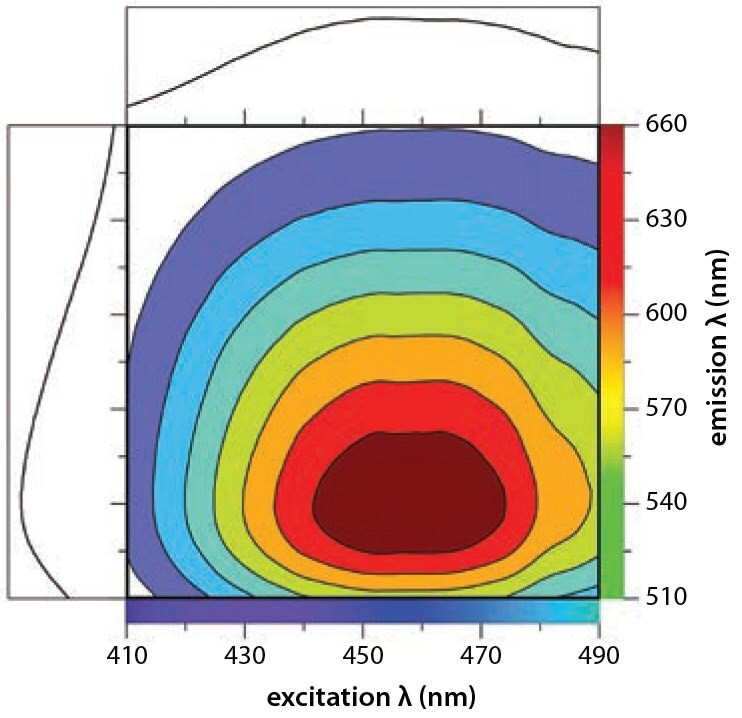
Figure 4.The 2D excitation/emission spectra of Y3Al5O12 : Ce3+. The excitation band shows a maximum around 460 nm, whereas the emission maximum is located at around 550 nm. The 1D excitation/emission spectra are shown on the left and top of the figure, and were taken using the emission/excitation wavelengths corresponding to the maximum intensity in the spectra.
Often, some of those requirements are conflicting. This means that, for example, broad emitting phosphors might possess a poor efficiency, while materials with suitable quantum efficiency may not cover the desired wavelength range with their emission spectrum. Some of those properties are strongly dependent on the dopant ion, whereas others are easily influenced by the host matrix. The challenge for materials scientists is thus to find the optimum combination of host lattice and activator ion(s) to eventually prepare stable, inexpensive, and efficient materials.
Phosphor Preparation
Various preparative methods have been developed to obtain phasepure and high-quality phosphor materials. Usually, high temperature solid-state reactions are the method of choice, meaning that the starting compounds (typically oxides, carbonates, or nitrates) are thoroughly mixed and homogenized and then subsequently heated at temperatures usually ranging from 1000 °C to 1600 °C. Reducing atmospheres, such as mixtures of H2 and N2 or CO gas, are often used in order to convert the dopant ion to the desired valence state (e.g., Ce3+ instead of Ce4+, and Eu2+ instead of Eu3+). Alternative reactions include solution-based approaches such as hydro- or solvothermal preparations, or sol-gel and spray pyrolysis methods.
More exotic synthetic pathways include combustion syntheses, as well as microwave-assisted solid state preparations,14 that offer unmatched reaction speeds, but much less control of the properties of the final product. The preparation of oxynitrides and nitrides often requires harsher conditions, such as very high temperatures (sometimes more than 2000 °C) and high N2 partial pressures in order to ensure incorporation of the nitrogen into the crystal lattice. Usually, air-sensitive precursors call for preparation steps under inert conditions, which is also true for some oxide materials.
Oxide Phosphors
Among the many different phosphor hosts that have been investigated, oxides have the largest share due to their ease of preparation and low cost production, often combined with excellent stability of the resulting compounds. By far the most widely used material in solid state lighting today is yttrium aluminum garnet, Y3Al5O12, doped with small amounts of cerium, abbreviated as YAG:Ce. The most efficient materials are prepared at temperatures above 1500 °C and are typically doped with 2 mol-% to 3 mol-% of cerium. An image of the unit cell is presented in Figure 5A. YAG crystallizes in a cubic space group Ia-3d and it consists of AlO4 tetrahedra and AlO6 octahedra that are completely corner-connected and form a stiff, highly connected three-dimensional network.
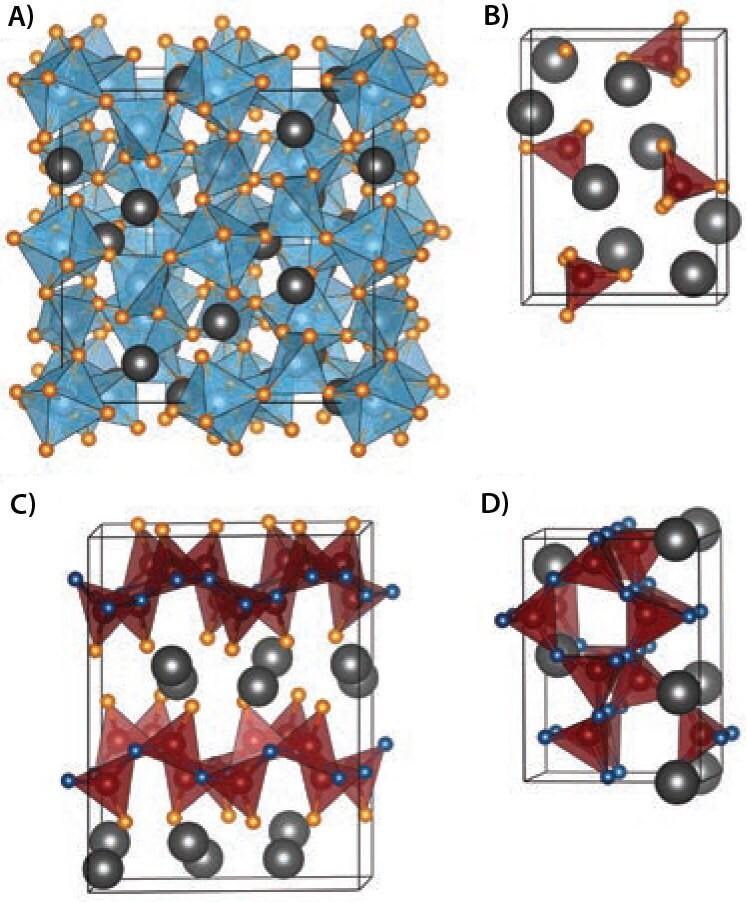
Figure 5.Schematic depictions of the unit cells of widely used phosphors. Here, A) shows the garnet Y3Al5O12, B) the orthosilicate Ba2SiO4, C) the oxynitride CaSi2O2N2 and D) the nitride Sr2Si5N8. Grey spheres represent Y, Ba, Ca and Sr atoms, while light blue, red, orange, and dark blue spheres represent Al, Si, O, and N atoms, respectively.
Y3+ ions occupy the voids within this network and these are coordinated by a total of eight oxygen ions, forming a distorted coordination environment. The Y3+ ions are also connected in three dimensions by their polyhedral edges, forming an intertwining network with the connected AlOn polyhedra in the manner of double gyroid structures known in block copolymers. First prepared by Blasse and Bril in 1967,15 YAG:Ce has become the canonical phosphor material in solid state white lighting applications. The reasons are manifold. Consisting only of relatively inexpensive and abundant elements, it can be prepared in large scales at a low cost. The optical properties make it a very good phosphor material as well. YAG:Ce shows a broad excitation band around 450 nm, making it a perfect fit for the emission of blue InGaN LEDs. The broad emission band of YAG:Ce is centered at around 550 nm, but reaches as far 650 nm (Figures 1 and 4), creating the aforementioned cool white light in conjunction with a blue light emitting diode.16
Additionally, it boasts several other very desirable properties, such as very good chemical and temperature stability. This is an important issue in phosphor-converted solid state lighting. Although much more electrical energy is transformed into visible light than in other lighting devices, the LED chip, which emits the radiation that eventually excites the phosphor, can reach temperatures of several hundred degrees Celsius. As shown in Figure 6, the emission wavelength of YAG:Ce does not change significantly with increasing temperature and the quantum efficiency drops only slightly below the value at room temperature, thus making long-term lighting applications feasible.
Also, the emission wavelength of cerium-doped YAG can somewhat be tuned by modifying its chemical composition (e.g., - substituting Y3+ by Gd3+, Lu3+, and the Al3+ by combinations of Mg2+ and Ge4+/Si4+). The change in the chemical composition leads to differences in the coordination environment of the emitting ion due to variations in the bond lengths or the strength and type of those bonds, thus modifying the crystal field splitting. Of course, the anionic composition can also be modified, as we will address later in the case of (oxy)nitrides. This chemical tuning of the emission wavelength of a phosphor is an important tool for the materials scientist.
Changes in composition play a very important role in another vast class of oxide phosphor materials, the orthosilicates. Possessing a very rich chemistry (almost 90% of the earth’s crust consists of silicates), some silicates, if doped with broad emitting ions (Ce3+, Eu2+), are remarkable phosphor materials that exhibit high quantum efficiency and good temperature stability. Here, we would like to briefly discuss the structure and properties of one of the simplest members of the phosphor silicate family, barium orthosilicate, Ba2SiO4. As its systematic name tells, the structure of Ba2SiO4 (orthorhombic space group Pnma) is composed of [SiO4]4- tetrahedra that are isolated from one another (thus orthosilicate), as shown in Figure 5B. The Ba2+ ions in this structure occupy two distinct crystallographic sites and are either 9- or 10-fold coordinated. Due to the uncomplicated synthesis (high temperature route in reducing atmospheres) and because of the ability to form solidsolutions with the strontium and calcium end members, phosphors from the orthosilicate family, especially the barium compounds, have been the focus of many research efforts.
The introduction of small amounts of europium ions leads to strong green emission (maximum centered around 505 nm) under near-UV (~395 nm) excitation (see also the color coordinates in Figure 1).17 This very intense emission in the green part of the spectrum makes it a suitable candidate for white light generation that relies on multiple color phosphors or phosphor blends.
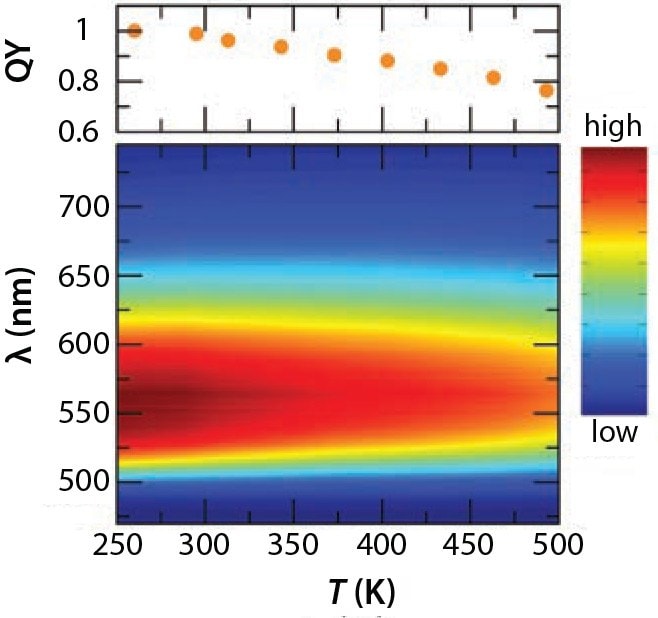
Figure 6.Temperature-dependence of the emission properties and the photoluminescence quantum yield of Y3Al5O12 : Ce3+.
(Oxy)nitride Phosphors
As briefly mentioned earlier, one possibility to tune the emission color (among other properties) is through the chemical substitution of either the cations or the anions. Another class of phosphors that is related to orthosilicates are oxynitrides from the family MSi2O2N2:Ln, where M is Ca, Sr or Ba and Ln is Ce3+ or Eu2+.18,19 A depiction of the unit cell of CaSi2O2N2 is shown in Figure 5C. It consists of alternating layers of Ca2+ ions and layers formed by a network of SiON3 tetrahedra that are connected via the three nitrogen terminated corners. The structures of the Sr and Ba MSi2O2N2:Ln oxynitrides are similar, however the difference in composition results in slightly different unit cell dimensions. Exhibiting high quantum efficiencies (up to 93% at room temperature) and very good temperature stability (quenching temperatures as high as 600 K for SrSi2O2N2 and BaSi2O2N2:Eu2+), these compounds and solid solutions thereof have quickly become well-studied and widely-used as alternative down-converting materials for white light emitting devices. If doped with divalent europium, the emission maxima of the pure compounds (i.e. CaSi2O2N2, SrSi2O2N2, BaSi2O2N2) is centered around 558 nm, 538 nm and 495 nm, respectively. Compositional tuning between these end members has led to very efficient yellow-green phosphors which are potentially substitutes for YAG:Ce.
A fourth class of phosphors is nitrides, which often have a red-shifted emission color when compared to oxides. The red shift is due to the large nephelauxetic effect in nitrides, which decreases the Racah interelectronic repulsion parameter of the activator ion and results in large crystal field splittings. Red emission from lighting is crucial for lowering the color temperature of lighting, making solid state lighting sources more pleasing to the eye and suitable for residential lighting applications. A well-known example of nitride phosphors is the family M2Si5N8:Ln, where M is Sr or Ba and Ln is Ce3+ or Eu2+.20,21 The structure is orthorhombic (space group Pmn21), shown for Sr2Si5N8 in Figure 5D. The unit cell consists of a fully connected network of corner sharing SiN4 tetrahedra, which extends in all three dimensions. The Sr2+ ions sit in the voids created by the SiN4 network, resulting in two distinct sites that are 6- and 7-fold coordinated. A complete solid solution can be formed with 100% Eu2+ substitution for Sr or Ba. Substitution of Eu2+ results in red emission from Sr2Si5N8 and yellow emission from Ba2Si5N8, while increasing amounts of Eu2+ red shift the emission to a maximum of 680 nm. The highly interconnected lattice of Sr2Si5N8 results in high quantum efficiency (up to 80% at room temperature) and very good thermal stability for a red emitting phosphor as shown in Figure 7.22 The excitation band of Sr2Si5N8:Eu2+ ranges from 370 nm to 460 nm and this, in addition to the highly efficient and stable red emission, make this compound an attractive choice for a conversion phosphor to add a red spectral component to InGaN-based warm white LEDs.
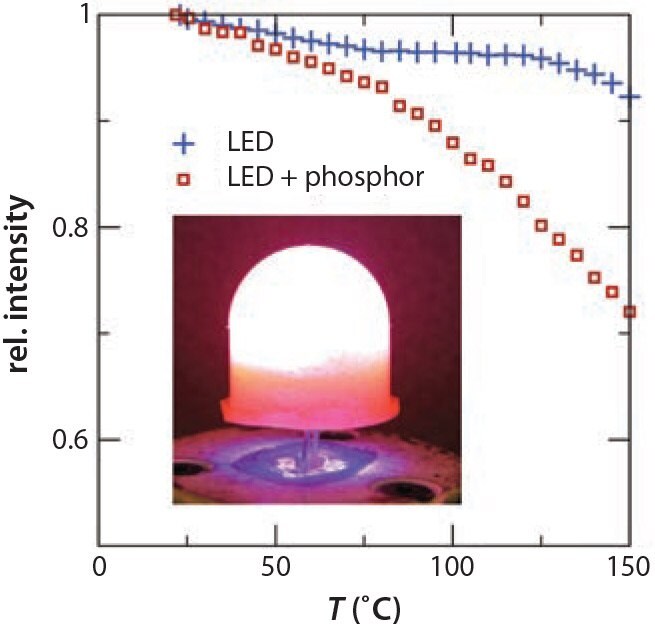
Figure 7.The relative intensity decrease of the Sr2Si5N8:Eu2+ phosphor and LED with increasing temperature shows the high thermal stability of this phosphor, uncommon among other red emitting phosphors. The inset shows a photograph of the phosphor encapsulated silicone cap illuminated by a blue LED.22
Summary
Solid-state lighting offers a potential for great energy savings. The performance of solid-state lighting devices critically depends on the down-converting phosphor or combination of phosphors used in the device. As we have shown, advanced inorganic materials including, but not limited to, oxides, oxynitrides and nitrides doped with small amounts of rare earth and/or transition metal elements, can be used as phosphors to efficiently create white light in a solid-state device.
Acknowledgements
We gratefully acknowledge support for work in the solid state lighting area from the Mitsubishi Chemical Center for Advanced Materials, and the Solid State Lighting and Energy Center at UC Santa Barbara, and would like to thank Steve DenBaars, Shuji Nakamura, and Glenn Fredrickson. We thank Stuart Brinkley and Alexander Mikhailovsky for their many collaborations. KAD and NCG gratefully acknowledge the NSF ConvEne IGERT Program (NSF-DGE 0801627) for fellowship support.
Materials
References
如要继续阅读,请登录或创建帐户。
暂无帐户?